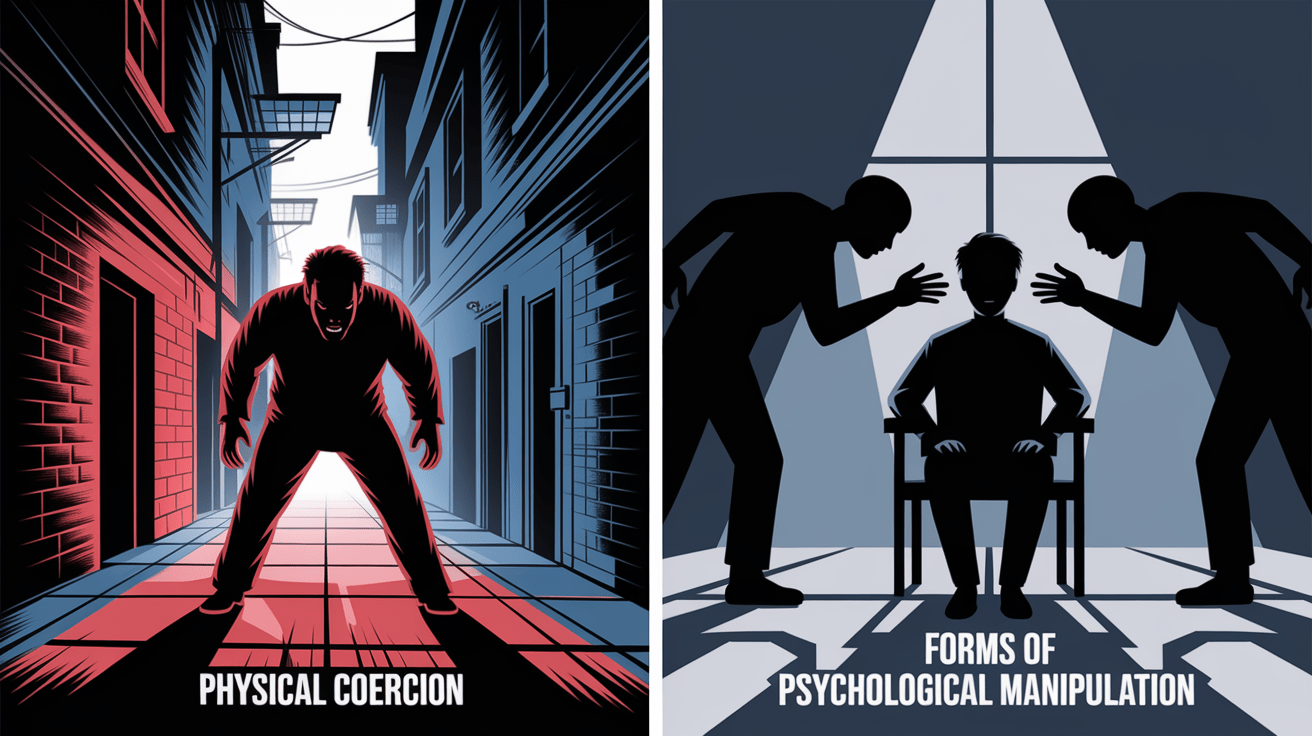Coercion in Psychology: Unveiling the Mechanics of Forced Compliance
At its core, human interaction hinges on autonomy—the ability to make choices freely, without external pressure. Yet, there are times when this fundamental principle is violated. The subtle or overt act of forcing someone to act against their own will is a powerful and often destructive force. This dynamic is the central focus of studying coercion in psychology, a field that explores how threats, intimidation, and pressure dismantle free will and compel compliance. Understanding its mechanisms is not just an academic exercise; it is crucial for identifying abuse, upholding ethical standards, and protecting individual autonomy in relationships, institutions, and society at large.
Opening the Vault: Defining Coercion in Psychology
What is the psychological definition of coercion? It refers to the act of influencing an individual to act against their will through the use of threats, punishment, force, or direct pressure. It fundamentally undermines and violates an individual’s free will, or voluntariness. Unlike voluntary action, behavior under coercion is not a product of internal desire but a response to external duress designed to eliminate other options.

Central to this definition is the concept of consent. True consent must be given freely, enthusiastically, and without pressure. Coercion makes authentic consent impossible. When an individual agrees to something because of a threat—whether it’s a threat of physical harm, emotional abandonment, or financial ruin—their “yes” is not an expression of autonomy but a survival mechanism. This is why actions performed under duress, such as confessions obtained through torture or agreements signed under undue influence, are often invalidated in legal and ethical contexts.
Psychological research defines coercion as any attempt to influence another person by manipulating the consequences of their actions, effectively forcing compliance by making resistance prohibitively costly.
Forms of Coercion: Physical vs. Psychological Manipulation
Coercion is not a monolithic concept; it manifests in various forms, broadly categorized as physical and psychological. Understanding the difference is key to recognizing its more insidious tactics.
Physical Coercion
Physical coercion is the most straightforward form of forced compliance. It involves the use or threat of physical force to compel an action. Examples are stark and often illegal, including:
- Direct threats of violence against a person or their loved ones.
- Physical restraint or imprisonment.
- Actions like extortion, blackmail, or even torture and sexual assault.
In these cases, the threat is explicit and the consequences of non-compliance are immediate and tangible physical harm.

Psychological Coercion
Psychological coercion, often termed emotional coercion or coercive control, is more subtle but no less damaging. It uses emotional and mental pressure to wear down an individual’s resistance. Instead of threatening the body, it targets the mind, self-worth, and emotional stability. Common psychological manipulation tactics include:
- Gaslighting: Making someone doubt their own perception of reality, memories, or sanity.
- Guilt-tripping: Inducing guilt to control another’s behavior.
- Withholding Affection: Using love, approval, or attention as a bargaining chip.
- Intimidation: Using threatening looks, gestures, or words to create a climate of fear.
- Isolation: Cutting a person off from their support network to increase their dependence on the coercer.
Mechanisms of Control: How Coercion Works
Coercion operates by creating a profound power imbalance and exploiting human psychology. The coercer establishes a dynamic where they control resources—be it safety, emotional validation, or financial security—and the victim must comply to access them or avoid punishment. This thrives on the fear of loss, compelling a person to choose the “lesser of two evils.”

This process fundamentally corrupts the mechanics of choice. It exploits inherent human cognitive biases, such as loss aversion (where the pain of losing something is felt more intensely than the pleasure of gaining something equivalent), to force a decision. In essence, coercion hijacks a person’s decision-making framework, a process explored in fields like behavioral economics and decision-making, which show how easily our choices can be manipulated when under pressure.
Coercion vs. Persuasion: A Critical Distinction
It’s important to differentiate coercion from persuasion. While both aim to influence behavior, their methods and ethics are worlds apart. Persuasion involves appealing to reason, emotion, and shared values to convince someone of a particular viewpoint, but it ultimately respects their autonomy to disagree. Coercion, on the other hand, eliminates meaningful choice. The psychology of persuasion can be used ethically to inspire and motivate, but when its principles are weaponized to threaten or intimidate, it crosses the line into coercion.
| Aspect | Persuasion | Coercion |
|---|---|---|
| Autonomy | Respects the individual’s right to choose freely. | Violates or removes the individual’s right to choose. |
| Method | Uses logical arguments, appeals to emotion, and evidence. | Uses threats, force, intimidation, and punishment. |
| Outcome | Voluntary agreement and internal acceptance. | Forced compliance based on fear or duress. |
| Power Dynamic | Aims for a balanced exchange of ideas. | Relies on a significant power imbalance. |
Real-World Settings: Where Coercion Emerges
Coercion is not confined to criminal interrogation rooms or hostage situations. It appears in everyday contexts, often hidden within the complex dynamics of human relationships.

In personal relationships, coercive control can be a feature of domestic abuse, where one partner systematically dominates the other. These toxic patterns, often invisible to outsiders, are a core focus of studies in interpersonal psychology and relationship dynamics. It also appears in parent-child relationships, workplaces (boss-employee), and even friendships.
Institutional settings are not immune. For example, research highlights ethical concerns about informal coercion in healthcare, where staff may pressure patients to adhere to treatment plans. While often well-intentioned, such practices can cause moral distress among staff and violate patient autonomy. Similarly, philosophers like John Rawls and Thomas Nagel have debated the coercive nature of governments, which use the threat of punishment (fines, imprisonment) to enforce laws and maintain social order. The key question in these contexts is whether the coercion is legitimate, ethical, and necessary for the greater good.
Lasting Effects: Psychological and Relational Impact
The consequences of being subjected to coercion are profound and long-lasting. Whether physical or psychological, a coercive experience is a form of victimization that can erode an individual’s mental and emotional well-being. Victims of sustained coercion often experience:

- Anxiety, depression, and post-traumatic stress disorder (PTSD).
- A diminished sense of self-worth and identity.
- Difficulty trusting others and forming healthy relationships.
- Loss of agency and the ability to make decisions for themselves.
- Chronic stress and related physical health problems.
Recognizing the psychological damage caused by coercion is the first step toward healing. Support for survivors must be sensitive to the unique nature of their experience. Approaches grounded in trauma-informed care are essential, as they prioritize safety, trust, and empowerment to help individuals reclaim the autonomy that was taken from them.
Prevention and Intervention: Reducing Coercive Practices
Combating coercion requires a multi-faceted approach, from public awareness to institutional reform. In fields like psychiatric care, where the line between necessary intervention and coercion can be thin, models like Safewards and the Six Core Strategies have shown promise in reducing the need for coercive measures like restraint and seclusion. These strategies focus on improving communication, preventing conflict, and creating a more collaborative and less confrontational environment.
On an individual level, prevention starts with education. Recognizing the signs of psychological coercion in a relationship is a critical skill for self-protection. These signs include feeling afraid of your partner, changing your behavior to avoid upsetting them, feeling isolated from friends and family, and doubting your own judgment. Ethical guidelines in psychology and other helping professions strictly prohibit coercion, emphasizing the importance of informed consent and client autonomy in all interactions.
Final Thoughts: Breaking Free from Coercion
Coercion, in all its forms, is an assault on human dignity. It strips individuals of their right to self-determination and creates relationships built on fear rather than respect. By understanding the psychological principles that underpin forced compliance, we can become better equipped to identify it, resist it, and build environments—in our homes, workplaces, and institutions—where free will is not a privilege but a protected right for all.
Key Takeaways
- Coercion is Forced Compliance: It is the act of compelling someone to act against their will through threats, intimidation, or force, thereby eliminating their ability to give genuine consent.
- It Has Two Main Forms: Physical coercion involves direct threats of harm, while psychological coercion uses manipulation tactics like gaslighting and guilt-tripping to control someone.
- Coercion is Not Persuasion: Persuasion respects autonomy and uses reason to convince. Coercion relies on power imbalances and fear to force an outcome.
- Recognize the Signs: Be aware of behaviors that create fear, dependency, and isolation in a relationship, as these are hallmarks of coercive control.
- The Impact is Severe: Coercion can cause significant psychological trauma, including anxiety, depression, and a loss of self-worth.
- Seek Informed Support: Healing from coercive experiences often requires specialized support, such as approaches rooted in trauma-informed care that help restore a sense of safety and autonomy.







